Nur 631 renal exam - Study guides, Class notes & Summaries
Looking for the best study guides, study notes and summaries about Nur 631 renal exam? On this page you'll find 16 study documents about Nur 631 renal exam.
Page 2 out of 16 results
Sort by
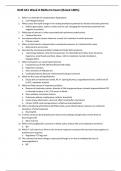
-
NUR 631 Week 8 Midterm Exam (Rated 100%)
- Exam (elaborations) • 4 pages • 2023
- Available in package deal
-
- $7.99
- + learn more
NUR 631 Week 8 Midterm Exam (Rated 100%)1. What is an example of compensatory hyperplasia a. Liver (Regeneration) 2. What causes the rapid change in the resting membrane potential to initiate and action potential. a. Sodium gates open, sodium rushes into the cell, changing the membrane potential from negative to positive. 3. What type of necrosis is often associated with pulmonary tuberculosis. a. Caseous Necrosis 4. Low plasma albumin causes edema as a result of a reduction in which press...
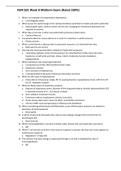
-
NUR 631 Week 8 Midterm Exam (Rated 100%)
- Exam (elaborations) • 4 pages • 2022
-
- $12.99
- 2x sold
- + learn more
NUR 631 Week 8 Midterm Exam (Rated 100%) 1. What is an example of compensatory hyperplasia a. Liver (Regeneration) 2. What causes the rapid change in the resting membrane potential to initiate and action potential. a. Sodium gates open, sodium rushes into the cell, changing the membrane potential from negative to positive. 3. What type of necrosis is often associated with pulmonary tuberculosis. a. Caseous Necrosis 4. Low plasma albumin causes edema as a result of a reduction in which pre...
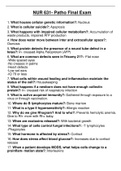
-
NUR 631- Patho Final Exam 2022/ 2023
- Exam (elaborations) • 0 pages • 2022
-
- $10.49
- + learn more
NUR 631- Patho Final Exam 1. What houses cellular genetic information?: Nucleus 2. What is cellular suicide?: Apoptosis 3. What happens with impaired cellular metabolism?: Accumulation of waste products, impaired ATP production 4. How does water move between inter and extracellular space?: Osmosis 5. What protein detects the presence of a neural tube defect in a fetus?: In- creased Alpha Fetoprotein (AFP) 6. What are common defects seen in Trisomy 21?: -Flat nose...
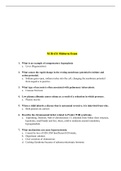
-
NUR 631 Week 8 Midterm Exam (Rated 100%)
- Exam (elaborations) • 6 pages • 2023
-
- $12.49
- + learn more
NUR 631 Week 8 Midterm Exam (Rated 100%) NUR 631 Week 8 Midterm Exam (Rated 100%) 1. What is an example of compensatory hyperplasia a. Liver (Regeneration) 2. What causes the rapid change in the resting membrane potential to initiate and action potential. a. Sodium gates open, sodium rushes into the cell, changing the membrane potential from negative to positive. 3. What type of necrosis is often associated with pulmonary tuberculosis. a. Caseous Necrosis 4. Low plasma albumin causes edema as a...
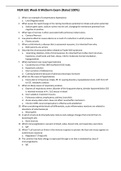
-
NUR 631 Week 8 Midterm Exam
- Exam (elaborations) • 4 pages • 2021
-
- $12.99
- + learn more
NUR 631 Week 8 Midterm Exam NUR 631 Week 8 Midterm Exam (Rated 100%) 1. What is an example of compensatory hyperplasia a. Liver (Regeneration) 2. What causes the rapid change in the resting membrane potential to initiate and action potential. a. Sodium gates open, sodium rushes into the cell, changing the membrane potential from negative to positive. 3. What type of necrosis is often associated with pulmonary tuberculosis. a. Caseous Necrosis 4. Low plasma albumin causes edema as a ...
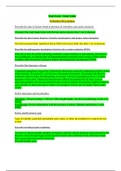
-
Grand Canyon University:NUR 631 Final Exam Study Guide (Fall Session)
- Study guide • 14 pages • 2020
-
- $18.98
- 1x sold
- + learn more
(NUR 631 Final Exam Study Guide) NUR 631 Final Exam Study Guide (Fall Session) Definitions/Descriptions Question: Describe the type of lesions found in psoriasis & seborrheic and actinic keratosis. Question: Describe the skin lesions found in Varicella (chickenpox) and herpes zoster (shingles). Question: Describe the pathogenetic mechanism of polycystic ovarian syndrome (POS). Question: Describe Hirschsprung’s disease. Question: Define marasmus and kwashiorkor. Question: Define deafferentatio...

That summary you just bought made someone very happy. Also get paid weekly? Sell your study resources on Stuvia! Discover all about earning on Stuvia


